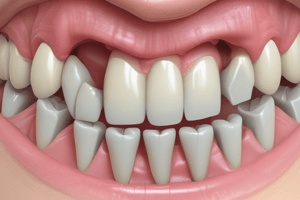Podcast
Questions and Answers
Biocompatibility refers to a material's ability to have adverse effects on living systems.
Biocompatibility refers to a material's ability to have adverse effects on living systems.
False (B)
What are biomaterials?
What are biomaterials?
A non-living material designed to interact with biological systems.
Which of the following are characteristics of biocompatibility? (Select all that apply)
Which of the following are characteristics of biocompatibility? (Select all that apply)
- Non-allergic (correct)
- Carcinogenic
- Toxic for patients
- Non-irritating to the oral cavity (correct)
What does biomechanics study?
What does biomechanics study?
Caries is caused by a bacterial biofilm commonly called ______.
Caries is caused by a bacterial biofilm commonly called ______.
Match the causes of dental issues with their descriptions:
Match the causes of dental issues with their descriptions:
What are some types of preventive dental materials? (Select all that apply)
What are some types of preventive dental materials? (Select all that apply)
Flashcards are hidden until you start studying
Study Notes
Course Information
- Textbooks include "Dental Materials" by John M. Power and John C. Wataha, and "Phillip’s Dental Materials" by Kenneth J. Anusavice.
- Assessment consists of quizzes (20 marks total), mid-term (30 marks), and final exam (40 marks, including continuous evaluation).
Course Learning Outcomes
- Identify different types and classifications of dental materials and their indications.
- Understand properties of dental materials including physical, chemical, mechanical behavior, and biocompatibility.
- Describe chemical compositions and setting behaviors of various dental materials.
- Master proper mixing and handling methods for dental materials.
Course Topics
- Introduction to dental materials and their properties.
- Gypsum products, polymers, and impression materials.
- Amalgam and both types of direct tooth-colored restorative materials.
- Principles of bonding, dental wax, casting alloys, and dental ceramics.
Biomaterials
- Defined as non-living materials designed to interact with biological systems, such as cardiovascular implants and dental restorative materials.
Biocompatibility
- Refers to the ability of a material to contact living systems without causing adverse effects.
- Essential traits include non-irritation to oral tissues, non-toxicity, non-allergic nature, and lack of carcinogenic properties.
Biomechanics
- The study of how biological materials interact and deform under environmental stress.
- Dental materials must withstand forces from mastication, occlusion, and temperature changes.
Dental Diseases & Restorative Materials
- Restorative materials prevent or repair damage from dental diseases like caries and periodontal disease or from trauma.
Caries
- Caused by a bacterial biofilm (plaque) that secretes acids leading to enamel and dentin dissolution.
- Carious lesions typically appear in areas where plaque accumulates, such as pits, fissures, and interproximal spaces.
Periodontal Disease
- Affects supporting tissues of teeth, including gingiva, periodontal ligament, cementum, and alveolar bone.
Impact of Trauma, Systemic Disease, and Genetic Disorders
- Trauma can cause fractures or displacement of teeth.
- Restorative materials are used to repair and stabilize damaged teeth.
Classification of Dental Materials
- Preventive dental materials include pit and fissure sealants, fluoride products, and therapeutic agents for decay and gum disease prevention.
- Mouth protectors are utilized to prevent trauma in patients.
Studying That Suits You
Use AI to generate personalized quizzes and flashcards to suit your learning preferences.




